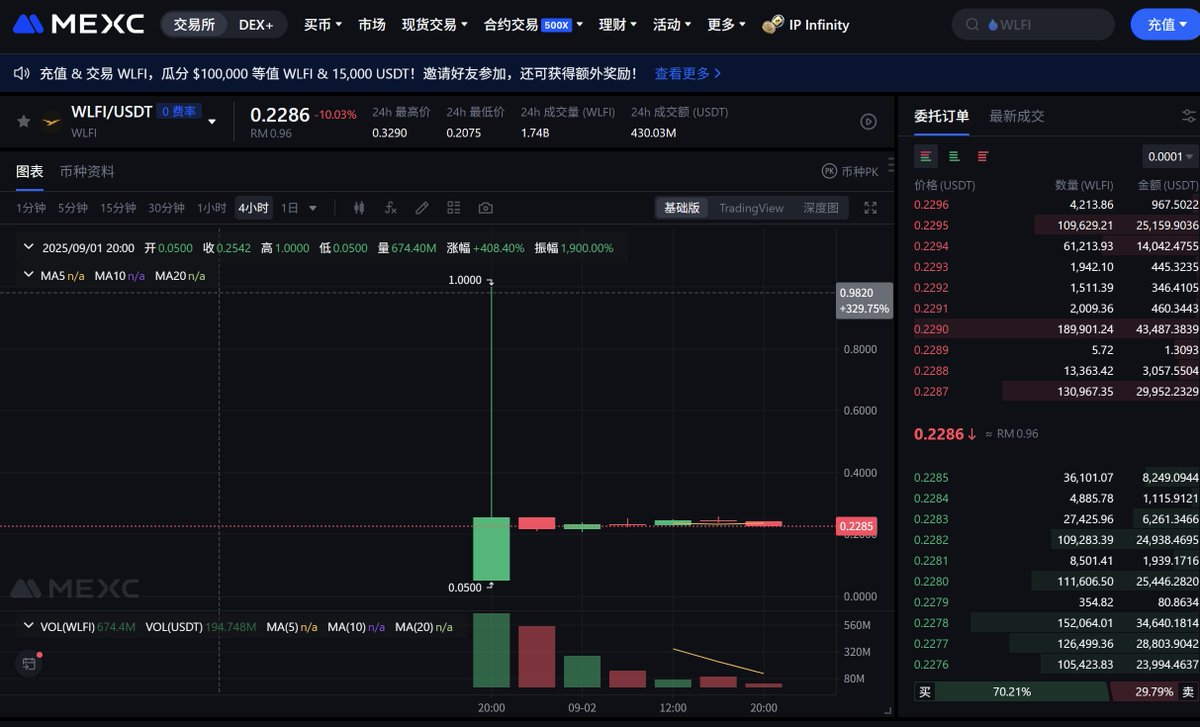Key Points
- Private investors' costs are as low as $0.015–$0.05, unlocking 20% on the first day yields a return of 6–20 times.
- Retail investors can only enter at $0.30 in the over-the-counter market, leaving almost no profit margin.
- The price dropped immediately upon opening, with WLFI plummeting to $0.21–$0.25 on its first day, as the political halo failed to prevent capital flight.
The issuance of WLFI is hailed as one of the most anticipated token events of 2025. Backed by a political brand and media presence, it attracted retail investors, institutions, and a broader crypto community. The market generally expected a strong surge on its first day; however, WLFI listed at around $0.30 on September 1, only to quickly drop to the $0.21–$0.25 range, catching many retail investors off guard. This article will outline the actual profit-making segments for investors before and after the WLFI listing and analyze why the token crashed on its opening day.
Feast for Private Investors
The biggest winners of WLFI are undoubtedly the early private participants. In 2024, the project raised approximately $550 million through private placements, with prices only at $0.015–$0.05. According to the unlocking mechanism, 20% of the tokens were released on the day of listing.
When WLFI listed at around $0.30, private buyers immediately enjoyed a paper profit of 6–20 times. Even selling a portion was enough to create significant selling pressure, directly contributing to the market downturn.
Airdrop Rewards and Over-the-Counter Trading
On the eve of the listing, WLFI airdropped USD 1 stablecoin to existing token holders, averaging about $47 per address. This reward effectively excluded external retail investors, continuing to lock in profits within the early group.
For retail investors, the only opportunity to intervene before the listing was through over-the-counter pre-trading on platforms like KuCoin and MEXC. Prices surged from private placement costs to $0.30–$0.36 in a short time and stabilized in the $0.30–$0.33 range before the listing. This meant that by the time retail investors could enter, their costs were already several times that of private investors, leaving almost no room for price increases.
First Day of Listing: Crash at Opening
WLFI landed on multiple exchanges on September 1, with Huobi and WEXC opening about an hour early, with prices nearly matching the over-the-counter trading. Unlike other tokens that typically rise before a correction, WLFI dropped directly from $0.30 to $0.21–$0.25 and eventually stabilized around $0.24.
Retail investors who bought at the opening almost immediately faced losses. Over-the-counter buyers also accelerated their selling due to the market failing to meet expectations, further exacerbating the decline.

Four Reasons Behind the Crash
First, heavy selling pressure from private investors. Early investors had extremely low costs, creating strong motivation to cash out at the $0.30 level.
Second, expectations were overdrawn in advance. The over-the-counter price had stabilized around $0.30, lacking new capital to drive the official listing.
Third, retail investors and over-the-counter buyers fled. The overlap between the opening price and the buying price led many investors to choose to cut losses or exit directly.
Fourth, lack of market-making support. The project team did not demonstrate strong support, and the political halo and promotional hype failed to translate into price support.
Limitations and Lessons for Retail Investors
The entire process of WLFI clearly reveals the limitations of retail investors. The massive profits during the private placement phase belong solely to institutions and qualified investors; airdrops only reward existing token holders; while over-the-counter trading is open, costs are high; and the official listing directly opened with a drop, leaving retail investors with almost no profit opportunities.
The core lesson from this case is that retail investors must recognize their disadvantages in information and channels. Understanding token economics and unlocking mechanisms is crucial. If insiders hold at costs far lower than retail investors, selling pressure is almost inevitable. Political narratives and media promotions cannot compensate for fundamental flaws; if the over-the-counter price has already overdrawn the potential for price increases, it is highly unlikely to explode again upon listing.
Conclusion
The issuance of WLFI once again illustrates that profit distribution in the crypto market often occurs before retail investors enter. Private investors and early holders realized substantial gains, while retail investors entered only at the opening, ultimately becoming the exit for liquidity.
In the future, when facing similar projects, if investors want to avoid becoming "the bag holders," they must conduct in-depth research on private placement structures, over-the-counter price trends, and unlocking psychology before the issuance. Otherwise, even the grandest issuance may simply mark the exit moment for the previous round of players.
免责声明:本文章仅代表作者个人观点,不代表本平台的立场和观点。本文章仅供信息分享,不构成对任何人的任何投资建议。用户与作者之间的任何争议,与本平台无关。如网页中刊载的文章或图片涉及侵权,请提供相关的权利证明和身份证明发送邮件到support@aicoin.com,本平台相关工作人员将会进行核查。




